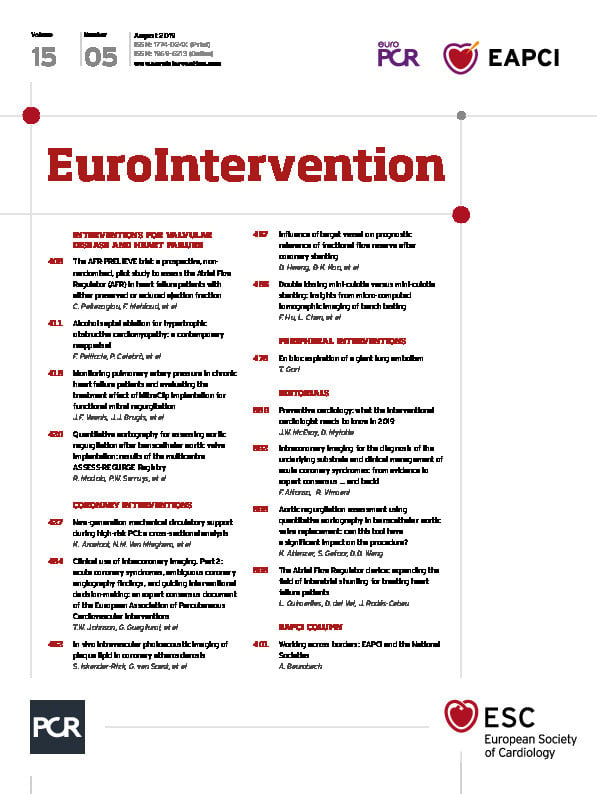
Despite decades of major advances in the treatment of patients with heart failure (HF), morbidity and mortality remain high regardless of aetiology. Increased left atrial pressure (LAP) leading to pulmonary congestion is the main mechanism precipitating acute decompensation and the worsening of symptoms. Implantable haemodynamic pressure monitoring has been shown to decrease HF hospitalisation and improve outcomes by guiding dose titration of drugs impacting on LAP1. Despite the benefits of device-guided therapy, it should be noted that most HF patients are elderly and exhibit multiple comorbidities which may represent a challenge for both medication self-titration and close follow-up. The creation of an interatrial shunting may facilitate an on-demand, autoregulating reduction of LAP. Recently, several studies have shown the feasibility, safety, and preliminary efficacy of interatrial shunting with a permanent device (InterAtrial Shunt Device [IASD®; Corvia Medical, Tewksbury, MA, USA], V-Wave device [V-Wave, Caesarea, Israel]) for treating HF patients with preserved and reduced ejection fraction (HFpEF, HFrEF)2.
In this issue of EuroIntervention, Paitazoglou et al report the results of the AFR-PRELIEVE trial, which included 36 HF patients (HFrEF: 16, HFpEF: 20) who remained symptomatic (NYHA Class III or ambulatory IV) despite optimal medical/device therapy3.
The patients received an interatrial shunting device (Atrial Flow Regulator [AFR]; Occlutech, Helsingborg, Sweden) and were followed for three months. The study had a primary safety endpoint (serious device-related adverse events), and efficacy parameters (functional status, quality of life, haemodynamic variables) were secondary endpoints. Shunt patency was evaluated by transoesophageal echocardiography (TEE) at three months. The AFR device was successfully implanted in all patients with a low rate of periprocedural complications and only one serious adverse event related to the procedure/device (one post-procedural episode of transient consciousness disturbance). All shunts were patent at three-month follow-up. Clinical and haemodynamic data were presented separately for each group (HFrEF and HFpEF). NYHA class improved early (within the first seven days) after the procedure in both groups. This improvement was maintained at three months (HFrEF: ∆ −1.4±0.2, p<0.001; HFpEF ∆ −1.1±0.2, p=0.003), along with significant improvements in quality of life status. Exercise capacity, as evaluated by the six-minute walk test, remained similar to baseline (HFrEF: ∆ 29.6±21.1 metres, p=0.18; HFpEF ∆ 25.9±22.1 metres, p=0.25), and pulmonary capillary wedge pressure (PCWP) decreased by some degree in both HFrEF (∆ −2.2±8.2; p=0.07) and HFpEF (∆ −5.2±8.8; p=0.03) patients.
Previous studies have shown that interatrial shunting for treating HF patients is a relatively simple procedure which is associated with a very low rate of complications2. The results of Paitazoglou’s work further support the feasibility and safety of this interventional treatment. Furthermore, the early improvements in functional status and quality of life are also consistent with prior studies with the IASD and V-Wave device in patients with HFpEF and HFrEF2. However, the study was limited by a small sample size, and the authors failed to present the global efficacy data for the entire study population. Rather, the results of each group (HFpEF and HFrEF) were reported separately, with ≤20 patients per group. This is likely to have had a negative impact on the study power for detecting significant changes in clinical and haemodynamic parameters following the procedure. To date, interatrial shunting has been associated with positive results in both HFpEF and HFrEF patients2, and it seems that this therapy may exhibit similar efficacy results in both entities. In any case, two ongoing randomised trials with the IASD and the second generation (valveless) of the V-Wave device (REDUCE LAP-HF TRIAL II [NCT03088033] and RELIEVE-HF [NCT03499236], respectively) are going to provide definitive data on the efficacy of interatrial shunting for treating HFpEF and HFrEF.
Some differential characteristics of the AFR device should be highlighted: (i) the need for balloon septum predilation prior to device deployment due to the lower radial force of the AFR device (which differentiates it from other available interatrial shunting devices), and (ii) the possibility of selecting two different device inner diameters (8 and 10 mm). Device size selection was based on computational simulation results and PCWP values. In summary, an 8 mm device was selected in patients who presented rest PCWP ≥15 mmHg, whereas a 10 mm device was selected in those who presented PCWP <15 mmHg at rest and ≥25 mmHg under exercise. The concept of different device sizes for interatrial shunting according to haemodynamic conditions is novel and interesting. However, the optimal device size for interatrial shunting in HF patients remains largely unknown. To date, devices with an inner diameter of 5.1 mm (V-Wave device) and 8 mm (IASD) have been used2. Using a computational model, Kaye et al4 demonstrated that an 8 mm shunt would generate a flow with Qp:Qs ~1.3-1.4 (at rest and under exercise) in HFpEF patients, resulting in a significant reduction in LAP and, to a lesser degree, an increase in right atrial pressure (RAP). Although the haemodynamic changes reach a plateau at a 9 mm shunt diameter, the most important reduction in LAP was observed at 6 mm, with reductions in LAP to less than 10 mmHg at rest and 20 mmHg under exercise in the simulation model. However, while this model may predict acute haemodynamic effects, the long-term consequences in RAP and right ventricular function should also be considered. In the congenital field, atrial septal defects (ASD) leading to a Qp:Qs ≥1.5 (usually corresponding to an ASD size ≥10 mm) are considered to be associated with significant negative haemodynamic effects5. In the AFR-PRELIEVE trial, about 23% of patients received the 10 mm fenestration device and HFrEF patients presented a mean Qp:Qs of 1.3, which is close to the cut-off of 1.5 used for indicating intervention (closure) in congenital ASDs. Unfortunately, Paitazoglou et al3 failed to report right ventricular function parameters at three-month follow-up. Of note, the IASD device (with an 8 mm inner diameter) was associated with some degree of RV dilation at six months, with no further dilation up to one year and no decrease in RV function6. Future studies are needed to determine the optimal shunt diameter associated with maximal beneficial effects while avoiding the negative impact on right ventricular function.
Another possible concern regarding permanent interatrial shunt devices is shunt patency over time. Evaluation of this with transthoracic echocardiography (TTE) may be challenging in some cases; TEE is a better option for obtaining reliable data on shunt permeability. Paitazoglou et al3 showed 100% shunt patency at three months, but shunt patency could not be assessed in about 14% of patients due to missing TEE data and suboptimal TTE images. Additionally, a three-month follow-up period may be too short for an accurate evaluation of shunt patency. Thus, 100% shunt patency was shown in the initial experience with the first-generation (valved) V-Wave device, but up to 50% of patients presented either shunt stenosis or occlusion at 12-month follow-up7. Whereas prior studies with the AFR device in the setting of pulmonary arterial hypertension showed full device patency at six-month follow-up8, future studies with a longer follow-up (at least 12 months) will be needed to provide definitive evidence on the shunt patency rates of the AFR device.
In conclusion, interatrial shunting has emerged as a new alternative for treating HF patients. The results of the initial experience with the AFR device showing a high procedural success rate along with a good safety profile and promising efficacy data are in line with previous studies with other interatrial shunting devices, further contributing to building evidence about this new interventional therapy. Ongoing randomised trials will finally shed light on the role of this intervention in patients with HFpEF and HFrEF. Overall, there are exciting times to come in the field of interventional therapies for treating HF.
Funding
D. del Val was supported by a grant from the Fundacion Alfonso Martin Escudero (Madrid, Spain). J. Rodés-Cabau holds the Research Chair “Fondation Famille Jacques Larivière” for the Development of Structural Heart Disease Interventions.
Conflict of interest statement
J. Rodés-Cabau is a consultant and proctor for V-Wave Inc. L. Guimaraes and D. del Val have no conflicts of interest relevant to the content of this paper to declare.

